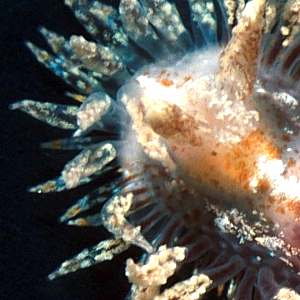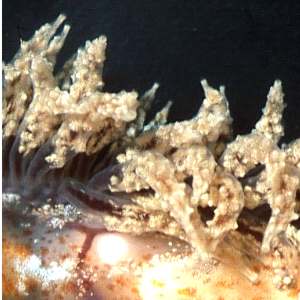

Janolus sp. 5
Order: NUDIBRANCHIA
Suborder: ARMININA
Family: Zephyrinidae
DISTRIBUTION
Known only from Victoria, Australia
PHOTO
Portsea Pier, Victoria, 19 December 2000. 7mm in length. Depth 4.5m. Photo: John Chuk.
This species, which has only been found in Victoria, was previously labelled Janolus cf. novozealandicus in the Forum. In comparison to J. novozealandicus, this Australian species has plumper cerata with many more pustules (they can easily be seen with the naked eye), including those on the upper third and, most distinctively, the pustule at the top of each ceras is enlarged and flattened at the tip so that it resembles a miniature suction cup. Internally, the tip of the digestive diverticulum is white, not gold as in J. novozealandicus.
Reference:
• Miller, M.C. & Willan, R.C. (1986) A review of the New Zealand arminacean nudibranchs (Opisthobranchia: Arminacea). New Zealand Journal of Zoology, 13: 377-408.
See John Chuk's message below.
See Richard Willan's message below.
Rudman, W.B., 2001 (June 9) Janolus sp. 5 [In] Sea Slug Forum. Australian Museum, Sydney. Available from http://www.seaslugforum.net/find/janosp5
Related messages
Antipodean Janolus hyalinus revisited
November 15, 2002
From: Richard Willan

PHOTO: Point Danger, Torquay, Victoria, Australia. Low spring tide. 18 May 1984. 30 mm extended crawling length. Collected by Robert Burn and photographed by
Richard Willan.
Dear Bill,
I have attached a scan of a Janolus specimen from Victoria, sthn Australia, to indicate the variation within this species that you have on the Forum as Janolus sp. 5. Previously I had considered it was the European Janolus hyalinus, but now it seems it occurs only in southern Australia. This undescribed species has brown spots on its body and the cerata have a golden band subterminally which is most visible in those cerata that are not heavily marked with white pigment. The cerata seem to be more transparent in younger animals or in those that have regrown their cerata following autotomy. In this species, the tip of the cerata is blunt and flattened, resembling a miniature suction cap, and this tip is sometimes quite enlarged as in the specimen John Chuk photographed at Portsea Pier. The digestive diverticulum extends almost to the apex of each ceras, but not quite.
Another reason for posting this image is to point out differences between this species and the animal Andrew Green photographed from the Poor Knights Islands in northern New Zealand back in May 1999 that also had pustulose cerata [see message 1, message 2]. This species now seems not to be Janolus sp. 5, nor J. hyalinus, and it is definitely not J. novozealandicus. I now think this is an another entirely different (also undescribed) species The cerata have numerous blue and gold specks and they are plumper than those of Janolus sp. 5, the pustules on the cerata are sparser and the digestive diverticulum extends to the very apex of each ceras. The Poor Knights Islands support tropical nudibranch species that arrive as larvae from the north and this number is definitely increasing in recent years (a fact I attribute to global warming), so Andrew's Janolus might be yet another example. This would really be a case of "Murphy's Law" operating, where you posted an undescribed species on the Forum that nobody had ever seen before.
Richard Willan
Richard.Willan@nt.gov.au


Dear Richard,
Thanks for this photo. The anterior cerata very happily show the blue and gold bands which link this with John Chuk's photos of what looks on first sight a different species. I am glad you now agree with me that there are two unnamed species in the New Zealand - sthn Australian region, neither of which are Janolus hyalinus. I am not quite sure why you have invoked "Murphy's Law" to explain why I have posted 'an undescribed species on the Forum that nobody has ever seen before'. One of the aims of the Forum is to enable professionals and interested amateurs to share their 'puzzles' and 'interesting finds' with others. These Janolus species, although a bit confusing initially, are an excellent example of how sharing ideas and information can significantly advance our knowledge.
To save further confusion I have renamed Andrew Green's species from Janolus cf. hyalinus to Janolus sp. 6. Hopefully I have made all the necessary 'behind the scenes' changes. If by chance I haven't and someone notices a weird link, I would be very grateful if you could let me know.
Best wishes,
Bill Rudman
Re: John Chuk's Janolus cf. novozealandicus
June 10, 2001
From: Richard Willan
Dear Bill,
In preparing pages on zephyrinids for the Forum could I add this comment on John Chuk's photo from Victoria which you have likened to Janolus novozealandicus. J. novozealandicus only occurs in New Zealand. When Michael Miller and I reviewed the New Zealand species of Janolus, the Australian species that is most closely related to it had not been discovered. This species, which has only been found in Victoria, and is probably much more bryozoan-faithful than J. novozealandicus, is the one John Chuk photographed at Portsea Pier and it is currently included on the Sea Slug Forum as Janolus cf. novozealandicus. It should be given a new species number because it has not received a scientific name yet. In comparison to J. novozealandicus, this Australian species has plumper cerata with many more pustules (they can easily be seen with the naked eye), including those on the upper third and, most distinctively, the pustule at the top of each ceras is enlarged and flattened at the tip so that it resembles a miniature suction cup. Internally, the tip of the digestive diverticulum is white, not gold as in J. novozealandicus.
References:
• Willan, R.C. & Coleman, N. (1984) Nudibranchs of Australasia. Australasian Marine Photographic Index, Caringbah, Sydney, 56 pp.
• Miller, M.C. & Willan, R.C. (1986) A review of the New Zealand arminacean nudibranchs (Opisthobranchia: Arminacea). New Zealand Journal of Zoology, 13: 377-408.
Richard Willan
Richard.Willan@nt.gov.au
Willan, R.C., 2001 (Jun 10) Re: John Chuk's Janolus cf. novozealandicus. [Message in] Sea Slug Forum. Australian Museum, Sydney. Available from http://www.seaslugforum.net/find/4541Thanks Richard,
Glad to have these at least partially resolved. It has become Janolus sp. 5 in the Forum.
Best wishes,
Bill Rudman
Zephyrinid from Victoria, Australia
February 23, 2001
From: John Chuk


Dear Bill,
Once again I seek your help in identifying a nudibranch. This one was photographed on a night dive at Portsea Pier, Victoria, on 19 December 2000. The specimen is 7mm in length and is covered in inflated papillose cerata. It was found at a depth of 4.5m, apparently feeding, on an arborescent bryozoan attached to a pylon. A portion of the bryozoan is visible in one of the photo's.
My guess would be a zephyrinid and possibly a Janolus sp.? Your opinion would be appreciated!
Many thanks for your help.
John Chuk
jchuk@giant.net.au
Chuk, J., 2001 (Feb 23) Zephyrinid from Victoria, Australia. [Message in] Sea Slug Forum. Australian Museum, Sydney. Available from http://www.seaslugforum.net/find/3772Dear John,
This is certainly a species of Janolus as can be seen by the tuberculose crest between the rhinophores.
One species with tubercules on the cerata has been reported from Victoria previously. and it has been identified as the European species, Janolus hyalinus, which Miller & Willan (1986) also report from New Zealand. As far as I can determine, that species in Europe does not have the blue and yellow pigmentation visible in your animal.
I wonder if it is the New Zealand species Janolus novozealandicus (Eliot 1907) which is characterised by blue and gold bands at the ceratal tips, and pustules on the cerata. The body has brown and opaque white patches, and grows to about 40mm.
In Miller & Willan's review they say " The closest known species to Janolus novozealandicus is J. hyalinus ... features in common are ground coloration, pustulose cerata, unbranched ceratal diverticula, .... However the two differ in several points ... J. novozealandicus has blue pigment on the sparsely pimpled cerata, a lozenge shaped patch of opaque white immediately behind the caruncle .....'
Your photo has both the blue on the cerata and the white patch behind the caruncle.
Reference:
• Miller, M.C. & Willan, R.C. (1986) A review of the new Zealand arminacean nudibranchs (Opisthobranchia: Arminacea). New Zealand Journal of Zoology, 13: 377-408.
Any comments and photos from people familiar with either species would be welcome
Best wishes,
Bill Rudman
